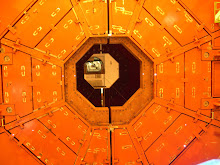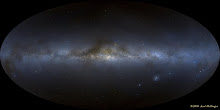 Billboard at the Geneva Airport. Or better still, VISIT GENEVA while you can. That's the LHC worst case scenario. Or if you believe some physicists, it could be the least of our worries. An unstoppable black hole produced right here could swallow the planet and maybe the Universe. Not yet anyway, probably not this summer when the Large Hadron Collider ring is fully commissioned. Possibly during the less dangerous 14 TeV proton to proton collisions soon after, or more likely eleven months later, when lead ion streams instead of lighter protons, are accelerated and forced to smash into each other at nearly twice the speed of light. Collision energies will be about 82 times higher, or 1,150 TeV.
Billboard at the Geneva Airport. Or better still, VISIT GENEVA while you can. That's the LHC worst case scenario. Or if you believe some physicists, it could be the least of our worries. An unstoppable black hole produced right here could swallow the planet and maybe the Universe. Not yet anyway, probably not this summer when the Large Hadron Collider ring is fully commissioned. Possibly during the less dangerous 14 TeV proton to proton collisions soon after, or more likely eleven months later, when lead ion streams instead of lighter protons, are accelerated and forced to smash into each other at nearly twice the speed of light. Collision energies will be about 82 times higher, or 1,150 TeV.Of course there is the conventional wisdom of more than 2,000 physicists on site, and another 6,000 accredited in 38 countries, working on this biggest machine of all time, who don't think it's that dangerous or probably not at all dangerous. The only certain thing, is nothing on this scale of a 27 km $10 billion experiment and at terascale 14 TeV energies of 14 trillion electron volts, has ever been attempted.
Add to this, the special conditions of the experiments. As CERN flatters the LHC in its glossy brochures, it's the coldest place and the hottest place in the Universe. Fortunately, not yet. Maybe later this year. Try beating the extreme cold employed, at 1.9 K or -271.3 C or colder than outer space and at a similar vacuum, the extreme magnetic fields, in the CMS experiment 4 Teslas or about 100,000 times earth's magnetic field, and the extreme heat generated by collisions, over 100,000 times the core temperature of our sun. If CERN gets this far without blowing up Geneva, then the LHC ALICE experiment with lead ions at collision energies of an unimaginable 1,150 TeV or 1,150 trillion electron volts, might deliver the Second Largest Big Bang.
In comparison a bolt of lightening, electrons of almost no mass, can deliver as much as 1 GeV or a gigascale billion electron volts. In its heyday the LEP, CERN's earlier Large Electron Positron collider at 40,000 metric tonnes of equipment, hoisted away 8 years ago to recycle the 27 km ring for the Large Hadron Collider, produced energies of 200 GeV.
Fermilab's Tevatron in Batavia Ill at over $370 million, is currently the most powerful collider with a 6.3 km main ring, producing collisions at 1.96 TeV.
 Cointrin
Cointrin

























No comments:
Post a Comment